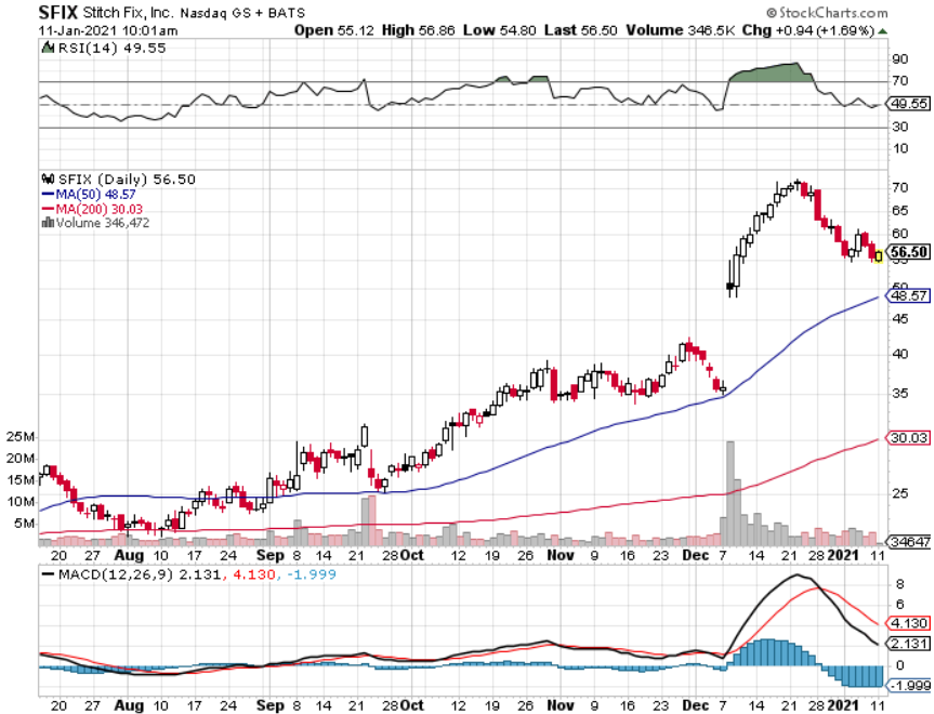Stitch Fix and its updated prognosis from management predicts 2021 results to look something like sales growth of 20% to 25% and that’s pretty damn good considering the less-than-ideal backdrop that corporate America is facing.
Even though I am not a big clothes guy personally, this tech apparel company is delivering value to customers by sending individually picked clothing and accessories items for a one-time styling fee. Customers fill out a survey online about their style preferences. A professional stylist at the company picks five items to send to the customer.
Last year, e-commerce could do no wrong and many stocks in the industry performed sensationally even hitting triple-digit percentages.
Employment is having a tough time coming back, the latest data suggest a long road to recovery and the vaccine rollout has been a pitiful exercise in efficient logistics.
This all means that 2021 will be more or less another year of click and collect from the confines of your abode made possible by ever-improving digital portals.
One of the disastrous industries last year, among many, was apparel, especially brick-and-mortar clothing and department stores.
Shelter-at-home lifestyles didn’t necessarily encourage consumers to handpick expensive dresses and suits, but as the economy slowly trends favorably, it can’t really get much worse than 2020, Stitch Fix should be one of the few winners in apparel among many losers.
Cutting to the chase, retail sales for apparel and accessories ended 2020 down nearly 30% year over year and you couldn’t make up what happened last year if you tried.
Restaurants experienced a 20% drop in sales because consumers simply evaporated highlighting the plight of many foundational industries.
Remote jobs and a wave of fresh self-employment are transforming consumer behavior in this shopping category, and I would bet that apparel consumption will never come back in the form it once was pre-pandemic which is why the use case of Stitch Fix's data-driven shopping experience could never be stronger.
That’s not to say that Stitch Fix had a record year in 2020.
They certainly didn’t.
Stitch Fix still had a bucket of problems in 2020 with a 9% year-over-year revenue decline during its fiscal 2020 third quarter (the three months ended May 2, 2020).
But even with such poor performance, it still represented a massive outperformance relative to other competition and finding those silver linings can be the most important for forward guidance.
This sets up Stich Fix for a massive rebound as consumers got used to the new lifestyle and sales returned with a reported 10% year-over-year growth in the first quarter of fiscal 2021 (ended Oct. 31, 2020).
And throughout the pandemic, Stitch Fix has continued to grow its client base around 9% to 10%.
The forecasted sales growth of 20% to 25% represents a substantial acceleration suggesting that 2020 was a “one-off” even likely to never reoccur.
Their total active clients stood at 3.76 million as of Oct. 2020, up from 3.42 million a year ago, and the company will improve on this growth while retaining past clients.
E-commerce is here to stay as consumers become conditioned to purchasing items in this fashion and a game-changing reason why Stitch Fix's own outlook is so rosy.
Looking forward the company's growth strategy revolves around acquiring new customers and entering new markets like many tech stalwarts before them.
Longer-term, Stitch Fix's data and machine learning capabilities, which helped the company get to where it is today, could be a real competitive advantage if it decides to make a foray into new clothing categories and beyond.
One issue to be aware of is that Stitch Fix generally caters to a pretty specific clientele and its services are only targeting specific price points.
The lower end of that range is still higher than what thrifty consumers may choose to spend and might even be considered a luxury for many.
The lower income tier of America simply won’t be able to make this work in its current form, and margins would drop if Stitch Fix ever accommodated this consumer group.
Despite the convenience Stitch Fix offers, many consumers like the idea of hand-picking clothing and trying it on in stores, where they have the option to instantly swap in and out a size for a better fit.
Stitch Fix does its best to estimate sizing based on user inputs and algorithms, but people are sized in different odd shapes and sizing can still miss the mark.
I don’t think Stitch Fix’s popularity will start to wane if working from home becomes the status quo in 2021 and 2022 and the need for higher-end wardrobes begins to decline because the company will simply need to adapt and focus more on pajama or comfortable clothing if the environment forces them to do so.
Believe me, I have noticed the uptick in the preference for outdoor sweatpants as the crisis went from bad to worse.
People simply don’t have time to dress up in these conditions, but consumers still need to wear clothes every day unless I am totally missing something.
Stitch Fix, in its current iteration, won’t replace department stores because it is too big of a swath from a low-income group that needs to access these services, but as scale terms into a positive input for the company, they can start looking at lower-income tiers for a revenue grab.
As Stitch Fix focuses on higher-end business, the runway is still mind-numbingly long and the optionality they possess is the envy of others.
They have too many good problems to have.
Stitch Fix looks like the cutting-edge apparel company that brings an innovated technology-based model to a stale industry.
It’s working and the first-mover advantage really means something here.
I would wait for a pullback to the low $50s range from the current $56.50 as shares are a little over their own skis.


